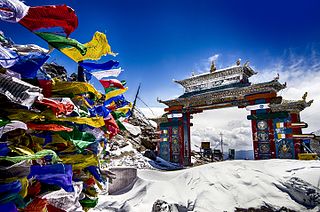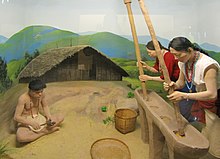
Arunachal Pradesh is a state in northeast India. It was formed from the North-East Frontier Agency (NEFA) region, and India declared it as a state on 20 February 1987. Itanagar is its capital and largest town. It borders the Indian states of Assam and Nagaland to the south. It shares international borders with Bhutan in the west, Myanmar in the east, and a disputed 1,129 km border with China's Tibet Autonomous Region in the north at the McMahon Line. Arunachal Pradesh is claimed by China as part of the Tibet Autonomous Region; China occupied some regions of Arunachal Pradesh in 1962 but later withdrew its forces.

Nagaland is a landlocked state in the north-eastern region of India. It is bordered by the Indian states of Arunachal Pradesh to the north, Assam to the west, Manipur to the south, and the Naga Self-Administered Zone of the Sagaing Region of Myanmar (Burma) to the east. Its capital city is Kohima and its largest city is the twin Chümoukedima–Dimapur. The state has an area of 16,579 square kilometres (6,401 sq mi) with a population of 1,980,602 as per the 2011 Census of India, making it one of the smallest states of India.

Northeast India, officially the North Eastern Region (NER), is the easternmost region of India representing both a geographic and political administrative division of the country. It comprises eight states—Arunachal Pradesh, Assam, Manipur, Meghalaya, Mizoram, Nagaland and Tripura, and the "brother" state of Sikkim.
The Indian state of Arunachal Pradesh has a total population of roughly 1.4 million on an area of 84,000 km2, amounting to a population density of about 17 pop./km2. The "indigenous groups" account for about two thirds of population, while immigrants, mostly of Bengali/Hindi belt origin, account for the remaining third.

The Nocte people, also known as the Nocte Naga, are a Tibeto-Burmese ethnic group primarily living in Northeast Indian state of Arunachal Pradesh. They number about 111,679, mainly found in the Patkai hills of Tirap district of Arunachal Pradesh, India. Ethnically related to the Konyak Naga, their origins can be traced back to the Hukong Valley in Myanmar, where they migrated from between the 1670 and 1700.

The Tangshang people or Tangsa Naga, are of Tibeto-Burmese ethnic group of the Arunachal Pradesh and Assam. They also reside in Sagaing Region and parts of Kachin State of Myanmar. In Myanmar they were formerly known as Rangpang, Pangmi, and Haimi. They speak their own language Tangsa.
Tirap district (Pron:/tɪˈɹæp/) is a district located in the southeastern part of the state of Arunachal Pradesh in India. It shares a state border with Assam, an international border with Myanmar and a district border with Changlang and Longding.

Nagas are various ethnic groups native to northeastern India and northwestern Myanmar. The groups have similar cultures and traditions, and form the majority of population in the Indian state of Nagaland and Naga Self-Administered Zone of Myanmar (Burma); with significant populations in Manipur, Arunachal Pradesh and Assam in India; Sagaing Region and Kachin State in Myanmar.
Khonsa is the headquarters of Tirap district in the Indian state of Arunachal Pradesh. It also houses Ramakrishna Sarada Mission School, Christ The King ICSE School. The Noctes, a Wancho tribe, are the indigenous population, although the town is cosmopolitan in nature, people from every Indian state can be found here. It is 43km away from Deomali Town.
The Aos are a major Naga ethnic group native to Mokokchung District of Nagaland in Northeast India. Their main territory is from Tsüla (Dikhu) Valley in the east to Tsürang (Disai) Valley in the west in Mokokchung District.

Mon District is a district of Nagaland, a state in India. It is the third-largest district in Nagaland in terms of area. The district has a population of 250,260 people. Mon Town is the headquarters of the district.

The Konyaks are a major Naga ethnic group native to the Northeast Indian state of Nagaland. They inhabit the Mon District, which is also known as The Land of the Anghs. The Anghs/Wangs are their traditional chiefs whom they hold in high esteem. Facial tattoos were earned for taking an enemy's head.

Roughly 8.6 per cent of India's population is made up of "Scheduled Tribes" (STs), traditional tribal communities. In India those who are not Christians, Muslims, Jews or Zoroastrians are identified as Hindus. The reason being varied beliefs and practices allowed in Hindusim and according of Hindusim as a geographical identity than merely Religious ones. Though, many of the Scheduled Tribes have modes of worship not typical to mainstream Hindusim but ontologically form part of the cultural practices of the land, as Nature or ancestral worship, with varying degrees of syncretism.
The Sal languages, also known as the Brahmaputran languages, are a branch of Tibeto-Burman languages spoken in northeast India, as well as parts of Bangladesh, Myanmar (Burma), and China.
The Konyak languages, or alternatively the Konyakian, Northern Naga, or Patkaian languages, is a branch of Sino-Tibetan languages spoken by various Naga peoples in southeastern Arunachal Pradesh and northeastern Nagaland states of northeastern India. They are not particularly closely related to other Naga languages spoken further to the south, but rather to other Sal languages such as Jingpho and the Bodo-Garo languages. There are many dialects, and villages even a few kilometers apart frequently have to rely on a separate common language.
The Changs are a Naga ethnic group inhabiting the Northeast Indian state of Nagaland. They were also known as Mazung in British India. Other Naga ethnic groups know the Changs by different names including Changhai (Khiamniungan), Changru (Yimkhiung), Duenching, Machungrr (Ao), Mochumi (Sümi) and Mojung (Konyak).
The Phoms are a Naga ethnic group native to the Northeast Indian state of Nagaland. Their traditional territory lies between the territories of Konyak in the north-east, the Ao in the west and the Chang in the south. Phoms celebrate several festivals in a year of which Monyiü is the greatest. It is celebrated from April 1 to 6 every year. Other traditional festivals include Moha, Bongvüm and Paangmo. They primarily inhabit the Longleng District.
Wancho (वांचो) is a Konyak language of north-eastern India. Wancho is spoken in 36 villages of southeastern Longding district, Tirap district, Arunachal Pradesh, as well as in Assam and Nagaland (Ethnologue). Alternate names include Banpara Naga, Joboka, Jokoba.
The largest religion in Nagaland is Christianity. The state's population is 1,978,502, as of 2011, out of which 87.93% are Christians. The 2011 census recorded the state's Christian population at 1,745,181, making it, with Meghalaya, Arunachal Pradesh, and Mizoram as the four Christian-majority states in India. The state has a very high church attendance rate in both urban and rural areas. The majority of churches are found in Kohima, Chümoukedima, Dimapur and Mokokchung.










